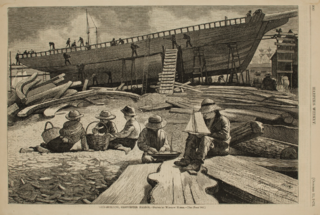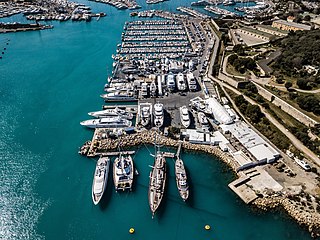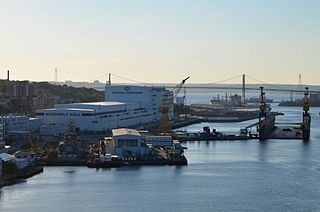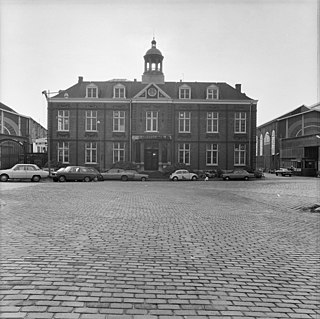
Vickers was a British engineering company that existed from 1828 until 1999. It was formed in Sheffield as a steel foundry by Edward Vickers and his father-in-law, and soon became famous for casting church bells. The company went public in 1867, acquired more businesses, and began branching out into military hardware and shipbuilding.

Aktien-Gesellschaft „Weser" was one of the major German shipbuilding companies, located at the Weser River in Bremen. Founded in 1872 it was finally closed in 1983. All together, A.G. „Weser" built about 1,400 ships of different types, including many warships. A.G. „Weser" was the leading company in the Deutsche Schiff- und Maschinenbau AG, a cooperation of eight German shipbuilding companies between 1926 and 1945.

Shipbuilding is the construction of ships and other floating vessels. It normally takes place in a specialized facility known as a shipyard. Shipbuilders, also called shipwrights, follow a specialized occupation that traces its roots to before recorded history.

A shipyard, also called a dockyard or boatyard, is a place where ships are built and repaired. These can be yachts, military vessels, cruise liners or other cargo or passenger ships. Compared to shipyards, which are sometimes more involved with original construction, dockyards are sometimes more linked with maintenance and basing activities. The terms are routinely used interchangeably, in part because the evolution of dockyards and shipyards has often caused them to change or merge roles.

Stonemasonry or stonecraft is the creation of buildings, structures, and sculpture using stone as the primary material. Stonemasonry is the craft of shaping and arranging stones, often together with mortar and even the ancient lime mortar, to wall or cover formed structures.

Mitsubishi Heavy Industries, Ltd. is a Japanese multinational engineering, electrical equipment and electronics corporation headquartered in Tokyo, Japan. MHI is one of the core companies of the Mitsubishi Group and its automobile division is the predecessor of Mitsubishi Motors.

Govan Shipbuilders Ltd (GSL) was a British shipbuilding company based on the River Clyde at Glasgow in Scotland. It operated the former Fairfield Shipyard and took its name from the Govan area in which it was located.

John Brown and Company of Clydebank was a Scottish marine engineering and shipbuilding firm. It built many notable and world-famous ships including RMS Lusitania, RMS Aquitania, HMS Hood, HMS Repulse, RMS Queen Mary, RMS Queen Elizabeth and Queen Elizabeth 2.

Bremer Vulkan AG was a prominent German shipbuilding company located at the Weser river in Bremen-Vegesack. It was founded in 1893 and closed in 1997 because of financial problems and mismanagement.

Sir Anish Mikhail Kapoor, is a British-Indian sculptor specializing in installation art and conceptual art. Born in Mumbai, Kapoor attended the elite all-boys Indian boarding school The Doon School, before moving to the UK to begin his art training at Hornsey College of Art and, later, Chelsea School of Art and Design.
Allied Shipbuilders Ltd is a privately held shipbuilding and ship repairing company established in Canada in 1948.

The Halifax Shipyard Limited is a Canadian shipbuilding company located in Halifax, Nova Scotia.
CSSC Offshore & Marine Engineering (Group) Company Limited (COMEC), formerly Guangzhou Shipyard International Company Limited (GSI), is the largest modern integrated shipbuilding enterprise based in Southern China. It was founded in 1954 and is parented by China State Shipbuilding Corporation (CSSC). It was reorganized and issued H share in Hong Kong Stock Exchange and A-share in Shanghai Stock Exchange in 1993 respectively. It is also the only shipbuilding stock listed in Hong Kong.
Offsite construction refers to the planning, design, manufacture and assembly of building elements at a location other than their final installed location to support the rapid speed of, and efficient construction of a permanent structure. Such building elements may be prefabricated offsite in a different location and transported to the site or prefabricated on the construction site and then transported to their final location. Offsite construction is characterized by an integrated planning and supply chain optimization strategy. Offsite manufacturing (OSM), offsite production (OSP) and offsite fabrication (OSF) are terms used when referring primarily to the factory work proper.
Kvaerner Govan Ltd (KGL), located at Govan in Glasgow on the River Clyde, was a shipyard subsidiary formed in 1988 when the Norwegian group Kværner Industrier purchased the Govan Shipbuilders division of the nationalised British Shipbuilders corporation. Prior to the Govan Shipyard's nationalisation in 1977, as a result of the Aircraft and Shipbuilding Industries Act, it had been operated by Govan Shipbuilders Ltd, which emerged from the collapse of the previous Upper Clyde Shipbuilders (UCS) joint venture in 1972. Prior to the formation of UCS in 1968, the Shipyard was operated by the Fairfield Shipbuilding and Engineering Company, which had a history extending back to 1834.

Hitachi Zosen Corporation is a major Japanese industrial and engineering corporation. It produces waste treatment plants, industrial plants, precision machinery, industrial machinery, steel mill process equipment, steel structures, construction machinery, tunnel boring machines, and power plants. Despite its name, Hitachi Zosen, of which the last word literally means shipbuilding, no longer builds ships, having spun off the business to Universal Shipbuilding Corporation in 2002, nor is it a keiretsu company of Hitachi any longer.

The ArcelorMittal Orbit is a 114.5-metre (376-foot) sculpture and observation tower in the Queen Elizabeth Olympic Park in Stratford, London. It is Britain's largest piece of public art, and is intended to be a permanent lasting legacy of London's hosting of the 2012 Summer Olympic and Paralympic Games, assisting in the post-Olympics regeneration of the Stratford area. Sited between the Olympic Stadium and the Aquatics Centre, it allows visitors to view the whole Olympic Park from two observation platforms.

Boustead Heavy Industries Corporation Berhad, often abbreviated as BHIC is a Malaysian industrial group specialised in defence, naval and commercial shipbuilding, ship repair, fabrication of offshore structures as well as maintenance, repair and overhaul of aircraft. The company is a public limited company and the largest shareholder is Lembaga Tabung Angkatan Tentera, a government statutory body which provides retirement benefits and a savings scheme for officers of the Malaysian Armed Forces, with a 58.69% stake. The second largest shareholder is Kumpulan Wang Persaraan, a company created by the Malaysian Government as an investment company, with a stake of 7.17%.

Gusto Shipyard, previously A.F. Smulders, was a shipbuilding company in Schiedam, Netherlands. It was famous for dredging and offshore vessels. In 1978 it was closed down under suspicious circumstances. Its engineering office still exists as GustoMSC, a subsidiary of American oil rig and equipment manufacturer NOV Inc.

















